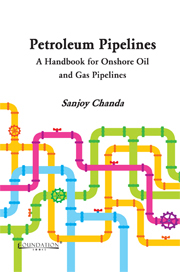Book contents
- Frontmatter
- Contents
- List of Tables and Figures
- Preface
- 1 Introduction: Some Basic Facts about Pipelines
- 2 Pipeline Design and Engineering
- 3 Pipeline Construction
- 4 Pre-commissioning and Commissioning of Pipelines
- 5 Operation and Maintenance of Cross-country Pipelines
- 6 Pipeline Corrosion and its Mitigation
- Bibliography
- Index
1 - Introduction: Some Basic Facts about Pipelines
Published online by Cambridge University Press: 05 September 2013
- Frontmatter
- Contents
- List of Tables and Figures
- Preface
- 1 Introduction: Some Basic Facts about Pipelines
- 2 Pipeline Design and Engineering
- 3 Pipeline Construction
- 4 Pre-commissioning and Commissioning of Pipelines
- 5 Operation and Maintenance of Cross-country Pipelines
- 6 Pipeline Corrosion and its Mitigation
- Bibliography
- Index
Summary
The appearance of petroleum in the world energy scenario revolutionized the fields of energy, transportation and industrial development and catapulted the world into what we called the modern era. We can no longer imagine living in a world without cars, aeroplanes and petrochemicals. It is no wonder that per capita consumption of petroleum is taken as a yardstick for a country's development. Contributing greatly to this success is the ability to transport and distribute petroleum products and natural gas – thus starting the story of pipelines.
Pipelines are suitable for transportation of any type of fluids. However, cross-country pipelines are, all over the world, mostly used for transportation of petroleum – both liquid and gas. In this book the term ‘pipeline’ will refer to liquid petroleum and natural gas pipelines. Cross-country pipelines are, except for very few exceptions, buried underground leaving the surface unspoilt and undisturbed. A pipeline operates literally beneath our feet without disturbing anybody's normal pursuit.
Pipeliners are fond of saying ‘pipelines are the lifelines of a nation’. It may sound self-important, but the statement is by and large true. The very fact that few are aware of the important role pipelines play is evidence of its success. Pipelines, lying underground, function silently and unobtrusively and, like the body's circulatory system, are an unseen but vital supply network transporting millions of tonnes of liquid petroleum and billions of cubic metres of natural gas in unbroken streams.
Information
- Type
- Chapter
- Information
- Petroleum PipelinesA Handbook for Onshore Oil and Gas Pipelines, pp. 1 - 19Publisher: Foundation BooksPrint publication year: 2013
